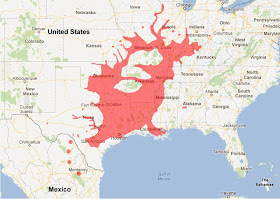A lot of folks stumble into this blog in their search for information about northern pecans. "Can I grow pecans successfully on my land and what cultivars should I plant?" These may be among the first questions asked by budding pecan enthusiasts, but before spending a single dime on nursery grown pecan trees, I think it wise to come to an understanding of the northern pecan tree's climatic adaptation.
Most avid gardeners have become familiar with the Plant Hardiness Zones Map (above). When people read about "northern" pecans they immediately think northern=cold hardy. Unfortunately, average mid-winter cold temperature (how the zone map is made) is a very poor predictor for pecan tree adaptation. Pecans grow natively and produce commercial pecan crops in zone 6 in central Missouri but pecan trees will never mature their nuts in zone 6 in Massachusetts even if the tree grows beautifully.
To understand pecan's adaptation to its environment it is best to start by looking at a map of the natural distribution of pecan in North America (marked in red above). Pecan is a tree that is native to the broad, rich, flood-plains of the Central United States. Note the huge holes in the center of pecan's distribution. These are the Ozark and Ouachita mountian ranges or areas that have narrow flood plains prone to trapping cold air in "frost" pockets. As you look at the edges of the distribution, note the long fingers of naturally occurring pecan trees. These areas coincide with major river flood plains. At my location in SE Kansas, pecans are located in the Neosho River flood plain. Other major rivers in the northern portion of pecan's native range include the Missouri, Mississippi, Illinois, Ohio, and Wabash rivers. In fact, the most northern location of naturally occurring pecan trees is the Mississippi River floodplain between Iowa and Illinois. But why is the natural distribution of pecan confined to the center of the country? The answer is summer heat, and lots of it.
Pecan is a heat loving crop and requires warm summer temperatures (especially warm night temps) to successfully ripen its nuts. The National Weather Service calculates what they call "annual cooling degree days" as a measure of summer heat and the demand for air conditioning (the formula is ((max temp + min temp)/2) - 65 Fahrenheit). A generalized map of cooling degree days is shown above. For the most part, you will note that the natural distribution of pecan is found in areas with at least 1000 cooling degree days. I frequently use cooling degree days information to help land owners determine if pecans are right for their location but summer heat must be combined with length of growing season to gain a true predictive understanding for pecan adaptation.
Pecan tree buds and foliage freeze at about 26 degree F. The freeze free period map above displays the number of days of temperature above 28 F that can be expected during the growing season. Pecans, even the earliest ripening clones, have all originated in areas with at least a 180 day freeze free period (above 28 F). Note the 180 day line spikes up the Mississippi River bottom between Iowa and Illinois just like the native range of the pecan. In terms of pecan adaptation outside the native range of pecan, I notice a finger 180 day growing season in central Pennsylvania. In the area around Harrisburg, PA (which also averages 955 cooling degree days) several nut growers have had success growing northern pecan cultivars.
By combining Cooling Degree Days information with the Freeze Free Period data, I can get a pretty good feel for where northern pecans will perform well. I always check local data instead of just relying on the over generalized maps shown above. My general rule of thumb has become that even the earliest ripening northern pecans need a minimum of a 180 day frost free period (based on 28 F) and 950 cooling degree days to properly grow and mature a nut crop.



